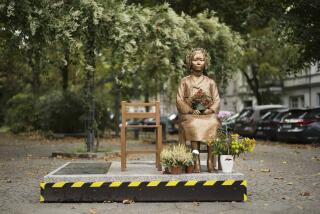Artist, Official Settle Dispute on Nude Statues
- Share via
A New York sculptor and the federal official who ordered two of his nude figures removed from a new federal building issued a joint statement Friday saying they expect to resolve the dispute by making undisclosed alterations to the sculpture site, but not to the sculpture.
Clearly seeking to defuse what had become a heated public arts controversy, the two sides said they were exploring “site enhancements” to “minimize the possibility of vandalism” to the two female figures. “Both parties are confident that the installation will be completed shortly,” the three-sentence statement concluded.
Both sculptor Tom Otterness, and a spokesman for Edwin Thomas, regional director of the General Services Administration, who had ordered the pieces removed on Dec. 2, said in interviews that they expected no recasting of the bronze sculptures of a woman and a newborn baby girl.
“I was worried that they (the GSA) might require something that would be really objectionable, but it doesn’t look like they’re asking for that,” Otterness said in an interview, his first since the figures were removed. “I think it is possible to both make the changes and stay true to the original intent and meaning of the work.”
When fully installed, his sculpture, titled “The New World,” will feature a 300-foot colonnade topped by friezes portraying a revolution that gives birth to a new world, as symbolized by a baby holding up a globe and bathed in a fountain of mist. The figure of the woman, a squatting, shackled philosopher reminiscent of Plato, was originally conceived partly as a commentary on public art, Otterness said.
The sculpture is to be placed in a patio of the new federal building, next to an existing federal office facility at San Pedro and Temple streets in downtown Los Angeles.
Just how the site will be altered is unclear. One partial solution, Otterness said, might be to raise the water level in the fountain around the baby, which U.S. District Judge Dickran Tevrizian, whose courtroom adjoins the patio, described as “a shrine to pedophiles.”
Otterness said he felt that part of the problem was a misunderstanding on the part of some of the building’s future tenants who, like Tevrizian, had access to the still-unopened patio before the sculpture was complete. That misunderstanding was exacerbated by the fact that until Wednesday, he said, he was in Europe opening new exhibitions.
The controversy erupted Dec. 2 when Thomas ordered the figures taken out, hours after he received a complaint from Rep. Edward R. Roybal (D-Los Angeles), who heads the congressional subcommittee that funds the GSA. The GSA, sometimes called the “government’s landlord,” manages federal properties.
At the time, Mary Filippini, a spokeswoman for Thomas, said the GSA found elements of Otterness’ work “unattractive” and planned to do a careful review of his proposal. “Simply speaking,” she said, “we are wondering whether what we approved is what we got.” She said Thomas had removed the pieces without notifying Otterness because the art was “federal property.”
Such remarks, combined with the impression that a powerful congressman had forced the GSA’s hand, prompted scores of protests from artists and other officials. Among those denouncing the move were the American Civil Liberties Union of Southern California and Mayor Tom Bradley.
At first, the controversy was expected to end in court as a test case of the 1990 Visual Artists’ Rights Bill, a complex law designed to protect artists against mutilation or unauthorized alteration of their work.
On Friday, however, both sides appeared eager to portray Thomas’ action as a temporary move to put the figures into storage for safekeeping from vandals until means could be developed of protecting them.
Asked what had become of GSA’s previous complaints about the art itself, Filippini said, “I’m not going to comment on that.”
Otterness’ attorney, Henry Welt, said talks are focusing exclusively on preventing vandalism to the work. In particular, he said, Thomas said he was concerned that, because federal building patios are often gathering places for demonstrations, demonstrators might deface the work.
“We fully expect a resolution,” Welt said.
When told of the compromise, Roybal said such talks were what he had hoped for in the first place. He said no one had been more surprised than he when the “wheels of bureaucracy had turned so fast” that the pieces were removed without consultation with the artist.
“Now it looks as though they’re going to reach an agreement,” Roybal said. “Whatever they decide is OK with me. I didn’t order it removed, and I won’t order it replaced.”
Roybal’s role in the controversy had surprised many artists, who held him in high regard since the 1950s, when as a Los Angeles councilman he cast a lone vote against a resolution condemning modern art as a “tool of the Kremlin.”
More to Read
The biggest entertainment stories
Get our big stories about Hollywood, film, television, music, arts, culture and more right in your inbox as soon as they publish.
You may occasionally receive promotional content from the Los Angeles Times.










